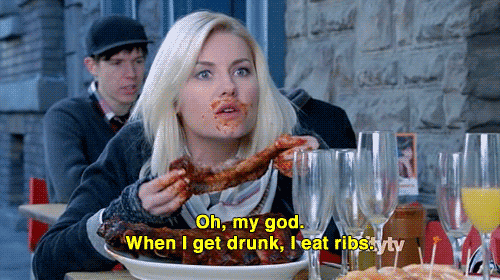A Beginners Guide To Wine Tasting Like A Pro
/Outside, the skies are grey. Any moment now, Mother Nature is about to unleash her fury, all but putting a dagger into your Saturday afternoon plans. Faced with yet another Grey’s Anatomy marathon on Netflix, someone suggests an afternoon of wine tasting. You look outside and make a face—while you enjoy drinking wine, you don’t really get the point of wine tasting. The last time you went wine tasting, you spent $30 at three different wineries and became so inebriated that you begged for meat on the way home. You're a vegetarian. Oops.
Wine tasting is one of those things that we can make as simple or as complicated as we want to. In theory, we taste wine and drink wine for very different reasons, which means theoretically, we should be taking contrasting approaches for each operation.
Why do you drink wine? Do you enjoy the way it tastes? Do you enjoy the way it enhances the flavors of your favorite dishes? Or, do you drink it simply because you like how it makes you feel? There’s no wrong answer to that question.
It’s important to grasp that the point of tasting wine isn’t enjoyment; it’s about analyzing any particular wine. Tasting wine is intended to help you learn about that particular style of wine. During a proper tasting, you should learn about the history of that wine, where and how it was produced, the characteristics of the wine you may (or may not) be tasting. How many times have you left a tasting room with a deeper knowledge and understanding about any particular wine you tasted that day? I can count on one hand how many times I’ve left a winery with an education about the bottle I just spent $125 on.
Part of the reason why I began this blogging journey was I wanted a deeper understanding and grasp of why I liked certain wines and what I enjoyed about the wines, and the whats and whys in regards to the wines that I disliked. I wanted to be able to explain to someone why I had chosen to gift them a certain bottle of wine; it’s not always because the label is eye-catching or it’s a bottle I’ve had lying around the house for a while and had a desire to re-home it. The vast majority of my friends and family have received wines from my husband and I the past several years and for the most part, I gift wines I generally like. Even the Chardonnays I have a tendency to giveaway, I can still put into words what I do like about that particular bottle, even though Chardonnay isn’t a wine I particularly enjoy drinking. No one has received a bottle of Pinot Noir from me that I personally purchased, because, well, I loathe Pinot Noir. To me, it smells like dirt and tastes like what I imagine a bar mat shot to taste like. (Note: I do realize that Pinot Noir doesn’t actually smell like dirt and that a mat shot would be far more disgusting than a glass of Pinot.)
To gain this understanding and knowledge, I wasn’t able to just simply spend an entire day going from winery to winery, doing tasting after tasting. I sought out technical tastings with wine directors of local restaurants, paid extra for private tours of wineries where the winemaker was doing the pouring and story-telling. By avoiding wine tasting with the mass public, for the most part, I avoided being influenced by outside elements such as distracting aromas (perfume, food, cigarettes), loud noises and loud, obnoxious wine-buzzed wine-tasters simply trying to pack in seven wineries in a single day. But I know that’s not realistic for everyday wine drinkers who are at the winery because their sunny weather plans were annihilated.
Three Tips For Productive Wine Tasting At The Winery
- Unless you’re on a mission to get wine wasted, consider spitting the wine you’re tasting. If you drink the entire contents of each glass you’re given to taste, your senses will not be what they were at the start of the day. You might think that spitting is rude; however, it’s actually accepted and expected.
- Listen to what is going on around you. If you’re drinking a chardonnay and you hear someone say they’re tasting banana while you’re tasting vanilla and star anise, listen to the words they’re using to describe that particular wine. By listening to what others are tasting and smelling, you’re going to expand your wine knowledge and vocabulary. Are you tasting something that you are unable to put into words? Perhaps someone alongside of you is able to eloquently describe exactly what you’re experiencing.
- Ask questions! If you’re curious about the blend mentioned on the bottle, ask the tasting room attendant about the process and percentage of each grape. Unfamiliar about what Tempranillo or Viognier is but see it mentioned on the bottle or the tasting notes? Seek answers!
Three Tips For Wine Tasting At Home
Perhaps the weather is so crummy that it would be dangerous to drive all around the country from winery to winery, so your friend suggests you host a wine tasting party in your home. She’s got six amazing wines that she knows everyone will love—so the question is, how do you get the most out of wine tasting at home? First of all, get yourself some fancy tasting note sheets, such as these ones.
- Blind tasting is an excellent way to experience wine without prejudice. If you’re like me and you hate Pinot Noir, you’re going to dislike any glass of Pinot Noir put in front of you. If you’re given a glass of wine and have no clue what it is (other than white or red), you’re able to remain objective and analytical about the particular wine you’re perhaps enjoying. Knowing very little about the wine you’re tasting actually benefits your tasting and analyzing abilities. You don’t have to wear a blindfold, just cover the bottle with a paper bag and do your best to not read the label. Once everyone has tasted the wine, begin discussing the wine; characteristics, varietal, vintage, origin, what food you’re dying to pair this with. If you’re drinking red wine and say chocolate, slap yourself.
- Taste wines in a specific order: white before red, lighter wines before heavier wines, with sweeter wines saved until the very end. If you begin your tasting adventure with the heaviest, boldest Cabernet Franc, those delicate light, aromatic white wines will be tarnished.
- Obtaining multiple vintages (year produced, not released) of the same wine is a fabulous way to taste the differences between particular vintages, the smells and colors will also be different from one vintage to the next. Perhaps you adore the 2010 but everyone else is gaga over the 2008! Similarly, obtain five wines from the same region (make sure they’re all the same wine from the same year: Merlot from Napa from 2012.) Assuming you didn’t select a manufactured wine, it’s a great way to understand how terroir works.














